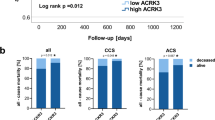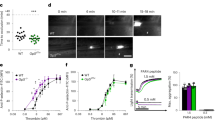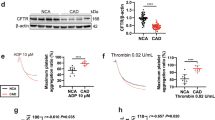Abstract
CD39, or vascular adenosine triphosphate diphosphohydrolase, has been considered an important inhibitor of platelet activation. Unexpectedly, cd39-deficient mice had prolonged bleeding times with minimally perturbed coagulation parameters. Platelet interactions with injured mesenteric vasculature were considerably reduced in vivo and purified mutant platelets failed to aggregate to standard agonists in vitro. This platelet hypofunction was reversible and associated with purinergic type P2Y1 receptor desensitization. In keeping with deficient vascular protective mechanisms, fibrin deposition was found at multiple organ sites in cd39-deficient mice and in transplanted cardiac grafts. Our data indicate a dual role for adenosine triphosphate diphosphohydrolase in modulating hemostasis and thrombotic reactions.
This is a preview of subscription content, access via your institution
Access options
Subscribe to this journal
Receive 12 print issues and online access
$209.00 per year
only $17.42 per issue
Buy this article
- Purchase on Springer Link
- Instant access to full article PDF
Prices may be subject to local taxes which are calculated during checkout







Similar content being viewed by others
References
Maliszewski, C.R. et al. The CD39 lymphoid cell activation antigen. Molecular cloning and structural characterization. J. Immunol. 153, 3574–3583 (1994).
Wang, T.-F. & Guidotti, G. CD39 is an ecto-(Ca2+, Mg 2+)-apyrase. J. Biol. Chem. 271, 9898–9901 (1996).
Kaczmarek, E. et al. Identification and characterization of CD39/vascular ATP diphosphohydrolase. J. Biol. Chem. 271, 33116– 33122 (1996).
Chadwick, B.P. & Frischauf, A.M. The CD39-like gene family - identification of three new human members (CD39L2, CD39L3, and CD39L4), their murine homologues, and a member of the gene family from Drosophila melanogaster . Genomics 50, 357– 367 (1998).
Fijnheer, R. et al. Stored platelets release nucleotides as inhibitors of platelet function. Thromb. Haemost. 68, 595– 599 (1992).
Heyns, A.d.P., Badenhorst, M. & Retief, F.P. ADPase activity of normal and atherosclerotic human aorta intima. Thromb. Haemost. 37, 429– 435 (1977).
Coade, S.B. & Pearson, J.D. Metabolism of adenine nucleotides in human blood. Circ. Res. 65, 531– 537 (1989).
Zimmermann, H. 5'-nucleotidase: molecular structure and functional aspects. Biochem. J. 285, 345–365 ( 1992).
Luthje, J. Origin, metabolism and function of extracellular adenine nucleotides in the blood. Klin. Wochenschr. 67, 317– 27 (1989); erratum: 67, 558 (1989).
Fredholm, B.B. et al. Nomenclature and classification of purinoreceptors. Pharmacol. Rev. 46, 143–152 (1994).
Daniel, J.L. et al. Molecular basis for ADP-induced platelet activation I–evidence for three distinct ADP receptors on human platelets. J. Biol. Chem. 273, 2024–2029 ( 1998).
Jin, J.G., Daniel, J.L. & Kunapuli, S.P. Molecular basis for ADP-induced platelet activation II - the P2Y1 receptor mediates ADP-induced intracellular calcium mobilization and shape change in platelets J. Biol. Chem. 273, 2030–2034 (1998).
Dubyak, G.R. & Elmoatassim, C. Signal transduction via P2-purinergic receptors for extracellular ATP and other nucleotides. Am. J. Physiol. 265,C 577–C 606 ( 1993).
Motte, S., Communi, D., Pirotton, S. & Boeynaems, J.M. Involvement of multiple receptors in the actions of extracellular ATP: the example of vascular endothelial cells. Int. J. Biochem. Cell Biol. 27, 1–7 (1995 ).
Marcus, A.J. & Safier, L.B. Thromboregulation: multicellular modulation of platelet reactivity in hemostasis and thrombosis. FASEB J. 7, 516–22 ( 1993).
Robson, S.C. et al. Loss of ATP diphosphohydrolase activity with endothelial cell activation. J. Exp. Med. 185, 153– 163 (1997).
Schafer, A.I. Vascular endothelium–in defense of blood fluidity. J. Clin. Invest. 99, 1143–1144 ( 1997).
Denis, C. et al. A mouse model of severe von-Willebrand-disease–defects in hemostasis and thrombosis. Proc. Nat. Acad. Sci. USA 95, 9524–9529 (1998).
Berger, G., Hartwell, D.Q., Wagner, D.D. P-selectin and platelet clearance. Blood 92, 4446–4452 (1998).
Koyamada, N. et al. Apyrase administration prolongs discordant xenograft survival. Transplant 62, 1739–1743 (1996).
Jin, J.G. & Kunapuli S.P. Coactivation of two different G protein-coupled receptors is essential for ADP-induced platelet aggregation. Proc. Nat. Acad. Sci.USA 95, 8070– 8074 (1998).
Bach, F.H. et al. Delayed xenograft rejection. Immunol. Today 17, 379–384 (1996).
Siess, W. Molecular mechanisms of platelet activation. Physiol. Rev. 69, 58–178 (1989).
Shen, J., Gimbrone, M.A.J., Luscinkas, F.W. & Dewey, C.F.J. Regulation of adenine nucleotide concentration at endothelium-fluid interface by viscous shear flow. Biophys. J. 64, 1323 –1330 (1993).
Sun, B., Li, J., Okahara, K. & Kambayashi, J. P2x(1) Purinoceptor in human platelets - molecular cloning and functional characterization after heterologous expression. J. Biol. Chem. 273, 11544–11547 (1998).
Weisman, G.A. et al. P2Y nucleotide receptors in the immune system: Signaling by a P2Y(2) receptor in U937 monocytes. Drug Dev. Res. 45, 222–228 (1998).
Weilerguettler, H. et al. A targeted point mutation in thrombomodulin generates viable mice with a prethrombotic state. J. Clin. Invest. 101 , 1983–1991 (1998).
Von Albertini, M. et al. Extracellular ATP and ADP activate transcription factor NF-kappa-B and induce endothelial cell apoptosis. Biochem Biophys Res Commun 248, 822–829 ( 1998).
Deguchi H. et al. Adenosine regulates tissue factor expression on endothelial cells. Thromb. Res. 91, 57– 64 (1998).
Bakker, W.W. et al. Experimental endotoxemia in pregnancy: in situ glomerular microthrombus formation associated with impaired glomerular adenosine diphosphatase activity. J. Lab. Clin. Med. 114, 531– 537 (1989).
Yang, Z.H. et al. Different interactions of platelets with arterial and venous coronary bypass vessels. Lancet 337, 939 –943 (1991).
Candinas, D. et al. Loss of rat glomerular ATP diphosphohydrolase activity during reperfusion injury is associated with oxidative stress reactions. Thromb. Haemost. 76, 807–812 (1996).
Gayle R.B. et al. Inhibition of platelet function by recombinant soluble ecto-ADPase/CD39. J. Clin. Invest. 101, 1851– 1859 (1998).
Sévigny, J., Levesque, F.P., Grondin, G. & Beaudoin, A.R. Purification of the blood vessel ATP diphosphohydrolase, identification and localization by immunological techniques. Biochim. Biophys. Acta. 1334, 73–88 ( 1997).
Baykov, A.A., Evtushenko, O.A. & Avaeva, S.M. A malachite green procedure for orthophosphate determination and its use in alkaline phosphatase-based enzyme immunoassay. Analyt. Biochem. 171, 266–270 (1988).
Bradford, M.M. A rapid and sensitive method for quantification of microgram quantities of protein utilizing the principle of protein-dye binding. Anal. Biochem. 72, 248–254 ( 1976).
Liu, M.A. Overview of DNA vaccines. Ann. N.Y. Acad. Sci. 772, 15–20 (1995).
Towbin, H., Staehelin, T. & Gordon, J. Electrophoretic transfer of proteins from polyacrylamide gels to nitrocellulose sheets. Procedure and some applications. Proc. Nat. Acad. Sci. USA 76, 4350– 4354 (1979).
Edelberg, J.M. et al. PDGF mediates cardiac microvascular communication. J. Clin. Invest. 102, 837–843 (1998).
Lundin, A., Richardsson A. & Thore, A. Continuous monitoring of ATP-converting reactions by purified firefly luciferase. Anal. Biochem. 75, 611–620 (1976).
Beurling-Harbury, C. & Harbury, P.B. Extraction of protein-bound ATP and ADP from human platelets in plasma. Thromb. Haemost. 63, 286–290 ( 1990).
Saito, H. et al. Plasma concentration of adenosine during normoxia and moderate hypoxia in humans. Am. J. Resp. Crit. Care Med. 159 , 1014–1018 (1999).
Dejana, E., Callioni, A., Quintana, A. & de Gaetano, G. Bleeding time in laboratory animals. II - A comparison of different assay conditions in rats. Thromb. Res. 15, 191 –197 (1979).
Johnson, E.N., Brass, L.F. & Funk, C.D. Increased platelet sensitivity to ADP in mice lacking platelet-type 12-lipoxygenase. Proc. Nat. Acad. Sci. USA 95, 3100–3105 (1998).
Koyamada, N. et al. Transient complement inhibition plus T-cell immunosuppression induces long-term survival of mouse-to-rat cardiac xenografts. Transplantation 65, 1210–1215 (1998).
Acknowledgements
We thank K. Koziak and E. Kaczmarek for expert assistance; F.H. Bach for advice; B. Talbot (Sherbrooke University, Québec, Canada) for his expertise in antibody production, and J.G. Lively (Cancer Research Institute, Massachusetts Institute of Technology) for technical advice regarding murine endothelial cell cultures. K.E. is a recipient of a Health Science Research Grant from the Japan Foundation for Aging and Health. J.S. is a recipient of fellowships from the Heart and Stroke Foundation of Canada and from "Fonds pour la Formation de Chercheurs et l'Aide à la Recherche du Québec". S.C.R. received support from Medical Research Council, University of Cape Town Liver Center, Cape Town, South Africa. This work was supported in part by National Institutes of Health grants HL57307 (S.C.R.), PO1-41484 (R.D.R.) and HL41002 (D.W.).
Author information
Authors and Affiliations
Corresponding author
Rights and permissions
About this article
Cite this article
Enjyoji, K., Sévigny, J., Lin, Y. et al. Targeted disruption of cd39/ATP diphosphohydrolase results in disordered hemostasis and thromboregulation. Nat Med 5, 1010–1017 (1999). https://doi.org/10.1038/12447
Received:
Accepted:
Issue Date:
DOI: https://doi.org/10.1038/12447
This article is cited by
-
Adenosine metabolized from extracellular ATP ameliorates organ injury by triggering A2BR signaling
Respiratory Research (2023)
-
CD39 in the development and progression of pulmonary arterial hypertension
Purinergic Signalling (2022)
-
Ectonucleotidases as bridge between the ATP and adenosine world: reflections on Geoffrey Burnstock
Purinergic Signalling (2022)
-
Ectonucleoside triphosphate diphosphohydrolases and ecto-5′-nucleotidase in purinergic signaling: how the field developed and where we are now
Purinergic Signalling (2021)
-
Targeting CD39 in cancer
Nature Reviews Immunology (2020)



